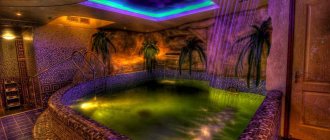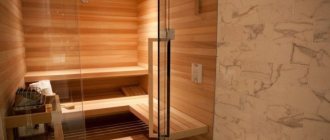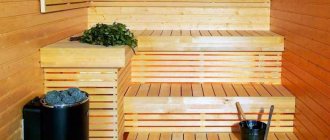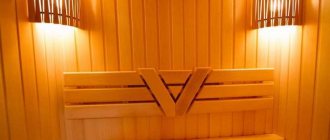A sauna in an apartment is a phenomenon that is not very common in Russia, but in Finland and other northern countries it is found everywhere. Of course, to arrange this at home, you will have to make an effort: understand what requirements the law imposes on saunas, obtain official permission, spend time and money.
However, the result is worth it: you can truly relax in the sauna, and an adequate approach to the matter will ensure strong immunity, heart health and good skin condition.
Sauna features
The ideal option is considered to be a bathroom - it already has all the communications you need, and to place a sauna you will not need to take additional permits from interested organizations. However, often closets, balconies are used for a sauna, or even attached to one of the walls of a large room. In these cases, the redevelopment of the apartment will have to be approved.
The second point that you should definitely pay attention to when installing a sauna is the electrical wiring. Since initially there was no provision for a sauna in the apartment, the electrical wires were not designed for the load from the stove. Therefore, it will have to be replaced, and possibly throughout the entire apartment at once (it is better to have this done by a professional electrician).
Dimensions of saunas for an apartment
The third point is the sauna stove itself. It must be electric and only factory-made (no homemade products, even from the best local craftsmen!). It is also not allowed to make any improvements to the factory furnace. The electric heater should turn off automatically after 8 hours of operation and have a power suitable for the volume of the room allocated for the sauna.
The fourth point is fire safety. Since a sauna is electricity, wood (a very flammable material!) and a fairly high temperature, the issues of ensuring fire safety must be approached thoroughly:
- invite specialists and install a fire alarm system in the apartment (if sensors have already been installed in the apartment, make sure that all general fire alarms are in working order);
- to decorate the sauna, use only hardwood;
- place the electric heater control panel outside the sauna in a dry room;
It should be possible to quickly and easily turn off the electrical “automatic machine” to which the sauna stove is connected when you are not using it (this is especially important if there are children in the apartment or who come to visit, who love to turn everything on and off) .
Fifth point: the door to the sauna must be specially made, preferably glass (otherwise the sauna will look like a small wooden box that can cause claustrophobia). And you need to purchase it before you start assembling the sauna frame.
Choosing a place: bath, kitchen or balcony?
When you live in a private house, you don’t have to make such a strict choice - you can use the basement, the attic, the extension, or one of the free rooms with equal success.
In a city apartment, everything is different: the attic and basement are public (although in Finland, for example, these rooms are equipped as a sauna for the entire house), it is prohibited to use them for your own needs (only for storing things, and even then not in all houses).
You can build an extension - but this applies exclusively to residents of the 1st floor, and construction on central streets is prohibited, and for peripheral houses a lot of approvals will be required, and therefore money.
What remains are the premises that are parts of the apartment, the so-called “living” area. Balconies, loggias and glazed verandas have recently also begun to be classified as “residential” meters
Let's look at the legal documents and see what is allowed by law. It turns out that placing saunas in living rooms and kitchens is strictly prohibited (by the way, the ban also applies to basements of high-rise buildings). What remains is a balcony (loggia), a corridor or a bathroom.
If you live in the north, your balcony will require high-quality thermal insulation, since the outer wall of the house usually freezes. The corridor needs redevelopment, and only if it has sufficient area. The pantry is usually used as a dressing room - this frees the living space from bulky cabinets.
Thus, a sauna in the bathroom should be considered a more rational solution, provided that the footage and legal regulations allow, which you will have to get to know more closely.
Advantages of the design
A sauna for an apartment has a number of advantages that should be taken into account when deciding on its arrangement:
- You can allow yourself rest and some relaxation at any time appropriate for this. Accordingly, you should not waste time going to the sauna.
- There is no need to carry out separate sewerage and water supply, as is the case when constructing a separate building with a sauna. You can connect the mini-sauna to a centralized sewerage/water supply system.
- The risk of catching colds is reduced, since you won’t have to run down the street.
- A mini-sauna for an apartment will have a beneficial effect on the entire body, removing toxins from it.
- Strengthening the cardiovascular system.
- An excellent remedy for restoring strength after a hard, stressful day, etc.
Considering these positive aspects, you may decide to purchase a mini-sauna for your apartment. However, consider the obvious disadvantage of this setup. It lies in the fact that there are not always free square meters in a residential apartment.
Phytobarrel
A phyto-barrel is a barrel-shaped structure made of cedar wood. The area of such a steam room is 1 square meter. Suitable for apartments with a regular layout. Does not exceed human height in height.
Equipped with a steam generator. Designed for a power of 2 kW. Some designs are equipped with a balm sprayer.
Companies sell phyto-barrels with installation. You shouldn’t equip your bathroom with them yourself.
Types of mini saunas
There are several types of saunas for installation in an apartment. They differ not only in price, but also in design, volume, heating method and other additional functions. Let's look at the most common saunas.
With electric heater
The area of such a sauna is 1.2 m2. If you have a small family, then this is a great solution. Its main advantage is the simplicity of installation work. As a rule, the factory assembly consists of a wooden frame, which is supplemented with shields. Two people are enough to assemble it.
A sauna with an electric heater already has a vapor barrier and thermal insulation in its design. Therefore, in addition to assembly, it will be necessary to connect to the water supply and sewerage system.
Phytobarrel
This sauna plan will require a minimum of space. Moreover, there is no need to further strengthen the electrical wiring. Based on the name, the design resembles the shape of a barrel. The entrance is located on the side. If you sit on a bench in it, your body is completely immersed in it, and only your head is outside.
The use of a phyto-barrel is important when steaming the body with medicinal herbs and various aromas, which has a positive effect on human health.
Portable sauna
This type of sauna is represented by a frame that is covered with fabric. Based on the principle of operation, a portable sauna is similar to a phyto-barrel. In it, the head is not subject to thermal influence. This device is relatively inexpensive, lightweight and does not take up much space. The main advantage is ease of use. It is enough to have a working outlet near the device.
IR sauna
In this case, an infrared emitter is used for heating. Although the temperature regime in it is considered gentle, in the region of 40–60°C, it warms the skin quite deeply. Therefore, it can include not only adults, but also children, as well as elderly people with heart and vascular diseases. One of the advantages of the installation is that it consumes little electricity.
Finnish
If the room in the apartment is large, then you can seriously think about purchasing a Finnish sauna. Several people can be in it at the same time. It uses dry steam to heat the temperature to 90–100°C and this is the main difference from the other saunas listed above.
Turkish
This sauna can rightfully be called exotic. It is very rarely installed in an apartment, since this requires:
- install hoods;
- make high-quality waterproofing;
- install heated floors;
- finish the floors with tiles, etc.
To produce steam in a Turkish bath, a steam generator is specially installed.
Materials for thermal insulation
The heater power in a small sauna is small, so high-quality thermal insulation of the walls and ceiling is needed. This will make it possible to maintain the appropriate temperature conditions with low energy consumption.
Attention: when purchasing insulation, you must abandon polystyrene foam and its various modifications. This material may melt when heated and produce harmful smoke.
For insulation, it is advisable to choose mineral wool insulation; it is not susceptible to temperature effects, and in terms of thermal properties it is not much inferior to polystyrene foam. The insulation is placed between the cladding slats, which are mounted on the walls and ceiling every 0.5 m. If the insulation is in contact with the brick, then polyethylene film should be used for vapor barrier.
If you use boards with thermal insulation rather than boards as cladding, then the walls do not need to be insulated. The shields consist of natural cork, which is soldered using its own resin. They are characterized by environmental friendliness and also have good moisture resistance.
The material must be mounted to a frame made of timber.
What to do if the wiring power is not calculated
Some restrictions on the operation of a sauna in an apartment may be imposed by insufficiently powerful wiring. Moreover, if the apartment has an electric stove with a power of over 3 kW, then the wiring will definitely not withstand the load. In this case, it will be necessary to make a small reconstruction of the wiring, and purchase a sauna stove with a power of up to 2 kW. But with such power, the temperature in the sauna will rise for a very long time. This, in turn, requires the installation of high-quality thermal insulation.
To install a sauna in an apartment, it is recommended to organize an individual supply of power cable, which is connected directly to the panel.
Important requirements are also imposed for the wiring inside the sauna. For this purpose, only closed wiring method should be used. The cable, in turn, must be heat-resistant. The sauna structure should be grounded, and an RCD should be installed on the line.
If you use an electric stove with a power of up to 4 kW, then this will not create a special load on the network. But it is not recommended to turn on the heater in the sauna at the same time.
Kinds
Electric mini-saunas for the home are presented in a wide range on the construction market. Finished designs may differ:
- power;
- sizes;
- location option;
- design;
- type of heating equipment.
There are several available options for ergonomic saunas for home use:
- Phyto-barrel. A compact steam room of a special design, made in the shape of a barrel. There are heating elements in the lower part, and a wooden bench for sitting in the upper part. To carry out bath procedures, just open the door and go into the barrel. In this case, the head will be located outside the structure, and the body will be located inside. For health procedures, you can use herbal infusions and decoctions.
- Portable fabric bath. The basis is a durable frame on which fabric is stretched, capable of ensuring optimal temperature in the steam room. To operate such a design, it is necessary to strengthen the electrical wiring and install waterproof sockets. The main advantage of such a bathhouse is its small dimensions and ease of installation and dismantling work.
- Finnish sauna cabin. A ready-made version of the design, which is intended for use in large apartments. It is distinguished by high reliability, practicality and high cost.
- Stationary bathhouse in the apartment. A structure with a unique design, the required size and equipment, which you can make and install yourself.
Legal subtleties and recommendations
Relatively recently, the idea of installing a sauna in an apartment had to be abandoned. However, today, if a number of requirements are met, this idea can be brought to life. So, to install a mini-sauna in an apartment, a number of the following conventions should be observed:
- Heating of the air in the sauna is possible only from the stove installed by the manufacturer. It provides automatic switches when the temperature reaches +130°C, as well as in the case of continuous eight-hour operation.
- To spray water in the sauna, install a perforated pipe or deluge. Connections to sewerage and water supply should only be made outside the sauna.
- The area of the room must be at least 24 m2.
- The wood used must be specially treated to protect it from fire and rot.
- It is prohibited to install a sauna in a residential area.
In order to approve a sauna in an apartment project, it is necessary to bypass such services as the housing inspection, fire service, homeowners' association, sanitary inspection service, etc. In different regions of the country, the number of authorities passed may differ, so in each individual case everything should be clarified in advance.
Registration of permission
You will have to obtain permission to install a sauna from the BTI. You will need a whole package of documents:
- copies of documents for the apartment - an extract from the register, a deed of gift, a purchase and sale agreement, a floor plan, an extract from the house register, and so on;
- a redevelopment plan, which indicates exactly what will be changed - it must be carried out by a construction company that has the appropriate license.
It is unlikely that permission will be issued the first time. Most likely, you will also have to visit the fire service, SES, and the architectural and construction supervision inspection. All these administrative services will testify that the sauna was built according to all the rules.
Necessary equipment
The sauna consists of a cabin and a special stove. The choice of stove power depends on the area of the steam room. On average, 0.6 kW per 1 m3 is calculated. If you buy more powerful equipment, you will have to spend more money on electricity. If the stove is weak, the sauna will take longer to heat up.
As for the cabin itself, you can make it yourself or purchase a ready-made factory model. For the frame, aspen, linden or coniferous trees are mainly used. Aluminum or galvanized steel can be used to construct the floor frame, but you can also use wood to construct a slatted floor.
Sun loungers should also be installed. Their number depends on the size of the room. They can also have different shapes, for example, L or U-shaped.
Stages of work
Prefabricated sauna
After all of the above five issues related to the arrangement of the sauna have been fully and efficiently resolved, you can begin the construction process itself.
We are building the frame of the sauna. To do this, we will need wood (timber), a drill, dowels and screws for attaching the timber to the wall, glassine (it will act as an external thermal insulation layer), a tool for working with wood, a building level, a tape measure, and a pencil.
Sauna for a city apartment
The simplest option is to attach the frame beam horizontally directly to the walls of the room allocated for the sauna. In cases where this is not possible (the room is larger than the sauna planned in it), it is necessary to install sufficiently thick wooden spacers between the floor and the ceiling (it is to them that the horizontal timber frame will be attached in the future).
The distance between the timber horizontally fixed to the wall should be as follows:
- 1 row - 3 cm from the floor,
- 2nd row – 60 cm from the floor,
- 3rd row – 1 meter from the floor,
- 4th row - stepping back 5 cm from the ceiling,
- Row 5 – exactly between the 3rd and 4th rows of timber.
The entire beam is aligned in one plane along the side that “looks” into the future sauna.
The ceiling frame is made of wide boards in increments of 60-70 cm. And do not forget about the vertical posts around the opening to which the door frame will be attached.
Be sure to make “frames” of timber around the supply and exhaust ventilation openings.
Wiring. In addition to the electric stove, the sauna must have at least one lamp (the switch for it must be located outside the sauna). Engage an electrician to install electrical wiring, who must place it in a metal hose.
Advantages of a sauna in an apartment
Sauna finishing. First, the ceiling is covered with clapboard, moving from the entrance to the sauna to the opposite wall. The cladding technology is as follows:
- stretch and secure the foil using buttons (one sheet),
- we fix 3-4 rows of lining (using nails driven into the groove),
- We install insulation into the resulting space,
- then we continue everything in the same way - foil (overlapping), lining, insulation.
The insulation should only be non-flammable - mineral wool. You cannot use polystyrene foam to insulate a sauna - it melts at high temperatures.
Stalls. The support for the benches in the sauna is made of timber. If you are making a bench above the bathtub, it is better to make it folding or removable. The support for the bench is fixed on three walls, and if necessary, a vertical stand with emphasis on the floor is also installed.
The flooring of the bench is assembled from boards with a width of at least 80 cm and a thickness of at least 20 mm in two rows (longitudinal and transverse). The width of the bench on which they will lie should not be less than 70 cm.
Sauna stove
The next stage is installing the heater (sauna stove) in accordance with the manufacturer’s instructions and securing the lamps. Using screws, you should attach a thermometer, ventilation valves and, of course, an hourglass to the lining.
And the last thing is to prepare the sauna for use: on the first day it is heated with the ventilation valves and doors open to 50-60 degrees, on the second day it is kept at the same temperature (but the door and valves are closed) for 3-4 hours, on the third day it is heated up to 90 degrees and maintain it for 3 hours, on the fourth day the sauna can be heated to 100 degrees for 3 hours, and then at maximum heating for half an hour you should periodically pour water onto the stones.
If no deficiencies are identified during these four days, the sauna can be used as usual.
Prices
As for the prices for a sauna for an apartment, they are different. It all depends on its type and configuration. Below are estimated prices for some types of saunas:
- Finnish sauna SR1D003 LUXURY CHROMOTHERAPY from 215 thousand rubles.
- Finnish sauna SR1T4026 LUXURY CHROMOTHERAPY TWIN from 400 thousand rubles.
- Infrared mini-saunas in the range of 120–260 thousand rubles.
- Turkish hammam saunas from 200 to 700 thousand rubles.











